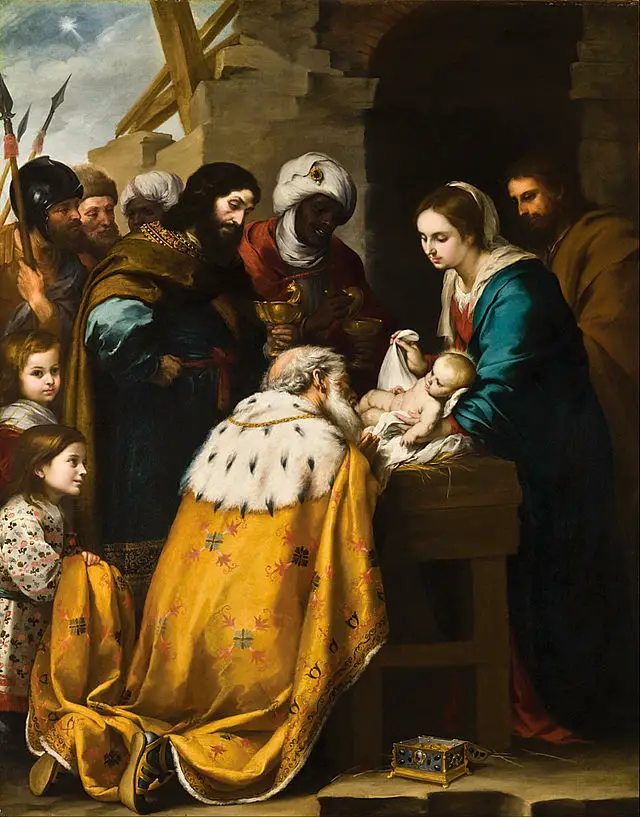1 February – Candlemas Eve
If you haven't taken down your Christmas decorations yet then don't worry, you're just following the medieval and Tudor tradition of taking them down on Candlemas Eve. 1st February was the traditional day for removing the greenery, such as laurel, holly, ivy and rosemary, which had decorated homes over the Christmas period. However, Candlemas Eve really is your last chance to rid your home of decorations and please don't leave them up otherwise you may just get invaded by goblins!
Down with the rosemary, and so
Down with the bays and misletoe;
Down with the holly, ivy, all,
Wherewith ye dress'd the Christmas Hall:
That so the superstitious find
No one least branch there left behind:
For look, how many leaves there be
Neglected, there (maids, trust to me)
So many goblins you shall see.
From Robert Herrick's 17th century poem Ceremony Upon Candlemas Eve.
2 February – Candlemas
Candlemas, also known as the Feast of the Presentation of Christ in the Temple and the Purification of the Blessed Virgin, commemorates the purification (or churching, as medieval people would have seen it) of the Virgin Mary forty days after the birth of Jesus Christ, when it was traditional for the mother to make an offering or sacrifice according to Jewish law, and the presentation of the baby Jesus at the temple in Bethlehem. Luke the Evangelist recorded this in his Gospel, Luke 2: 22-39:
And when the days of her purification according to the law of Moses were accomplished, they brought him to Jerusalem, to present him to the Lord; (As it is written in the law of the Lord, Every male that openeth the womb shall be called holy to the Lord;) And to offer a sacrifice according to that which is said in the law of the Lord, A pair of turtledoves, or two young pigeons. And, behold, there was a man in Jerusalem, whose name was Simeon; and the same man was just and devout, waiting for the consolation of Israel: and the Holy Ghost was upon him. And it was revealed unto him by the Holy Ghost, that he should not see death, before he had seen the Lord's Christ. And he came by the Spirit into the temple: and when the parents brought in the child Jesus, to do for him after the custom of the law, Then took he him up in his arms, and blessed God, and said, Lord, now lettest thou thy servant depart in peace, according to thy word: For mine eyes have seen thy salvation, Which thou hast prepared before the face of all people; A light to lighten the Gentiles, and the glory of thy people Israel. And Joseph and his mother marvelled at those things which were spoken of him. And Simeon blessed them, and said unto Mary his mother, Behold, this child is set for the fall and rising again of many in Israel; and for a sign which shall be spoken against; (Yea, a sword shall pierce through thy own soul also,) that the thoughts of many hearts may be revealed. And there was one Anna, a prophetess, the daughter of Phanuel, of the tribe of Aser: she was of a great age, and had lived with a husband seven years from her virginity; And she was a widow of about fourscore and four years, which departed not from the temple, but served God with fastings and prayers night and day. And she coming in that instant gave thanks likewise unto the Lord, and spake of him to all them that looked for redemption in Jerusalem. And when they had performed all things according to the law of the Lord, they returned into Galilee, to their own city Nazareth.
King James Version.
In his book The English Year, Steve Roud explains that, as the name suggests, Candlemas's “key element” was “the preponderance of candles”. Candles were blessed in church services and then carried around the parish, their light symbolising Christ lighting the way for his followers and harking back to Simeon's words recorded in Luke about Christ being “A light to lighten the Gentiles, and the glory of thy people Israel”. Ronald Hutton, in The Stations of the Sun, writes of how in the 15th and early 16th centuries the craft guilds of Aberdeen “provided pageants to accompany their members through the streets with their candles...” and that some towns and cities held municipal feasts and put on entertainment.
It appears that the practice of blessing candles was frowned upon after the Reformation, with Archbishop Thomas Cranmer writing to Bishop Bonner on 27th January 1548 informing him that the Lord Protector has decided “that no candles should be borne upon Candlemas Day, nor also from henceforth ashes or palms used any longer.” It was seen as superstitious.
3 February – Feast of St Blaise
St Blaise (Blaize, Blaze) was a Cappadocian bishop who became the English patron saint of wool-combers, as well as being the patron saint of wax-chandling and wild animals. On his feast day, wool combers would have special processions to celebrate their craft. St Blaise is also the patron saint of those with sore throats and people could (and still can in some Catholic churches) get their sore throats blessed on this day by the priest.
14 February – Valentine's Day
Steve Roud, in The English Year, writes of how the origins of Valentine's Day are “obscure” and that the romantic traditions associated with it have nothing to do with either of the martyrs believed to have been the St Valentine commemorated on this day.
Geoffrey Chaucer wrote in the 14th century of how birds would choose their mates on Valentine's Day and this theme has been repeated in other pieces of literature. In John Lydgate's 15th century poem, “A Valentine to her that Excelleth All”, he writes of how it was custom on Valentine's Day for people to choose their love:
To look and search Cupid's calendar
And choose their choose, by great affection.
In her book Pleasures & Pastimes in Tudor England, historian Alison Sim writes of how the Tudors obviously did celebrate St Valentine’s Day because it is mentioned three times in the Paston Letters in the 1470s. Apparently, “valentines were chosen by lot from among a group of friends, who then had to buy their valentine a gift.” Sim goes on to describe how the steward’s accounts of the household of William Petre show lengths of cloth and gold trinkets being given to valentines who were chosen by lot and that one year “one of the maids was even fortunate enough to draw Sir William himself one year, and was given a whole quarter’s extra wages as her valentine.”
24 February – Feast of St Matthias the Apostle
In the medieval and Tudor era the feast of St Matthias the Apostle was celebrated on 24th February, whereas today it is celebrated on 14th May. I have read also that the feast was celebrated on 25th February in Leap Years.
Matthias was not one of the original twelve apostles, he was chosen after the Ascension of Jesus by the remaining eleven apostles to replace Judas Iscariot. Why was it important to replace Judas? The Catholic Online website explains: "Twelve was a very important number to the Chosen People: twelve was the number of the twelve tribes of Israel. If the new Israel was to come from the disciples of Jesus, a twelfth apostle was needed." The Book of Acts explains what happened:
Then returned they unto Jerusalem from the mount called Olivet, which is from Jerusalem a sabbath day's journey.
And when they were come in, they went up into an upper room, where abode both Peter, and James, and John, and Andrew, Philip, and Thomas, Bartholomew, and Matthew, James the son of Alphaeus, and Simon Zelotes, and Judas the brother of James.
These all continued with one accord in prayer and supplication, with the women, and Mary the mother of Jesus, and with his brethren.
And in those days Peter stood up in the midst of the disciples, and said, (the number of names together were about an hundred and twenty,)
Men and brethren, this scripture must needs have been fulfilled, which the Holy Ghost by the mouth of David spake before concerning Judas, which was guide to them that took Jesus.
For he was numbered with us, and had obtained part of this ministry [...]
Wherefore of these men which have companied with us all the time that the Lord Jesus went in and out among us,
Beginning from the baptism of John, unto that same day that he was taken up from us, must one be ordained to be a witness with us of his resurrection.
And they appointed two, Joseph called Barsabas, who was surnamed Justus, and Matthias.
And they prayed, and said, Thou, Lord, which knowest the hearts of all men, shew whether of these two thou hast chosen,
That he may take part of this ministry and apostleship, from which Judas by transgression fell, that he might go to his own place.
And they gave forth their lots; and the lot fell upon Matthias; and he was numbered with the eleven apostles.
So, Peter's criteria for this new apostle was that he had to have been with them from the beginning, "all the time that the Lord Jesus went in and out among us", so that he could be a true witness to everything Jesus had said and done. Two men fit the bill: Matthias and Joseph called Barsabus. As you can see, the apostles prayed and then cast lots. Matthias was chosen.
Little is known of Matthias, but the lost Gospel of Matthias of the New Testament Apocrypha was attributed to him. According to Nicephorus Callistus Xanthopoulos, the Byzantine historian, and the fifth century Synopsis of Dorotheus, Matthias preached the Gospel in Judea and the region of Colchis in Aethiopia (Ethiopia), while other traditions have him preaching in Cappadocia and around the coastline of the Caspian Sea. Nicephorus writes of him being martyred while Dorotheus has him dying at Sebastopolis and being buried near the Temple of the Sun there. Other traditions are that he was stoned to death, beheaded or killed by an axe or lance. Still others have him being imprisoned by Ethiopian cannibals and being rescued by the apostle Andrew, before going on to preach at Damascus and then dying peacefully at Phalaeon, in Judea. Hippolytus of Rome writes of him dying of old age in Jerusalem. He's a bit of a mystery character! Whatever the case, he was with the other apostles at Pentecost, when the Holy Spirit came down on them, and it appears that he went on to preach and spread the Christian faith.




Leave a Reply